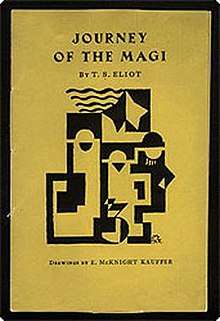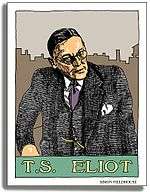Journey of the Magi
Journey of the Magi is a 43-line poem written in 1927 by T. S. Eliot (1888–1965). It is one of five poems that Eliot contributed for a series of 38 pamphlets by several authors collectively titled Ariel poems and released by British publishing house Faber and Gwyer (later, Faber and Faber). Published in August 1927, "Journey of the Magi" was the eighth in the series and was accompanied by illustrations drawn by American-born avant garde artist Edward McKnight Kauffer (1890–1954).[1] The poems, including "Journey of the Magi", were later published in both editions of Eliot's collected poems in 1936 and 1963.[2]
| by T. S. Eliot | |
 The cover of the poem's first publication, Faber & Gwyer's 1927 pamphlet | |
| Written | 1927 |
|---|---|
| First published in | Ariel poems |
| Illustrator | Edward McKnight Kauffer |
| Form | Dramatic monologue |
| Meter | Free verse |
| Publisher | Faber and Gwyer |
| Publication date | August 1927 |
| Lines | 43 |
In the previous year, Eliot had converted to Anglo-Catholicism and his poetry, starting with the Ariel Poems (1927–1931) and Ash Wednesday (1930), took on a decidedly religious character.[3] In the poem, Eliot retells the story of the Magi who travelled to Palestine to visit the newborn Jesus according to the Gospel of Matthew. It is a narrative, told from the point of view of one of the magi, that expresses themes of alienation and a feeling of powerlessness in a world that has changed. The poem's dramatic monologue incorporates quotations and literary allusions to works by earlier writers Lancelot Andrewes and Matthew Arnold.
Writing and publication

In 1925, Eliot became a poetry editor at the London publishing firm of Faber and Gwyer, Ltd.,[4]:pp.50–51 after a career in banking, and subsequent to the success of his earlier poems, including "The Love Song of J. Alfred Prufrock" (1915), "Gerontion" (1920) and "The Waste Land" (1922).[5] In these years, Eliot gravitated away from his Unitarian upbringing and began to embrace the Church of England. He was baptised into the Anglican faith on 29 June 1927 at Finstock, in Oxfordshire, and was confirmed the following day in the private chapel of Thomas Banks Strong, Bishop of Oxford.[4]:pp.18[6]:pp.20,212,223 Eliot converted in private, but subsequently declared in his 1927 preface to a collection of essays titled For Lancelot Andrewes that he considered himself a classicist in literature, a royalist in politics, and an Anglo-Catholic in religion.[6]:p.223[7][8] When his conversion became known, it was "an understandable choice to those around him" given his intellectual convictions, and that "he could not have done anything less than seek what he regarded as the most ancient, most sacramental, and highest expression of the Christian faith that forms the indisputable basis for the culture and civilization of modern Europe".[4]:pp.18 Eliot's conversion and his adherence to Anglo-Catholicism informed and influenced his later poetry.[3]
Critical reviews of Eliot's poems shifted as well, with some critics asserting that Eliot's work suffered with the addition of Christian themes.[9] One critic, Morton D. Zabel said that this "deprived his art of its once incomparable distinction in style and tone".[10] Other critics thought Eliot's exploration of Christian themes was a positive development in his poetry, including Gordon Symes, who recognised it as "an evaluation of old age, an elucidation of its special grace, and an appreciation of its special function in the progress of the soul".[11][12]
In 1927, Eliot was asked by his employer, Geoffrey Faber, one of the partners in Faber & Gwyer, to write one poem each year for a series of illustrated pamphlets with holiday themes to be sent to the firm's clients and business acquaintances as Christmas greetings.[4]:pp.19,50,376 This series, called the "Ariel Series", would release 38 pamphlets from a selection of English writers and poets from 1927 through 1931. The first poem that Eliot wrote, "Journey of the Magi", was released as the eighth in the series in August 1927. Eliot would follow with four more poems: "A Song for Simeon" in August 1928, "Animula" in October 1929, "Marina" in September 1930, and "Triumphal March" in October 1931. Four of Eliot's five Ariel poems, including "Journey of the Magi", were accompanied by illustrations by American-born avant garde artist, E. McKnight Kauffer.[1][3][13][14]
Faber & Gwyer, Ltd., printed the "Journey of the Magi" in a 7¼" × 4 ¾", Octavo (8vo) pamphlet "line block in black with brown and grey; casing, thin card covered with yellow laid paper."[13][15][16] The font of the cover and poem text was "Imprint" created by Gerard Meynell & J. H. Mason in 1913 for the printing trade magazine The Imprint.[16] The poem was printed on two pages, accompanied a colour images by Kauffer, and included one page of advertisements. Faber & Gwyer contracted with the Curwen Press in Plaistow to print 5,000 copies.[13] There was a limited edition of 350 copies that was printed "on Zanders' hand-made paper".[16] According to Gilmour, the edition was printed "in batches of eight."[17] A yellow cover was used for Eliot's poem after Curwen's designer Paul Nash objected for its use in the seventh Ariel pamphlet, Siegfried Sassoon's "Nativity".[17]
In 1936, Faber & Faber, the successor firm to Faber & Gwyer, collected "Journey of the Magi" and three of the other poems under the heading "Ariel Poems" for an edition of Eliot's collected poems.[2] ("Triumphal March" appears as Section 1 of "Coriolan" in the "Unfinished Poems" section.) When Faber released another series in 1954, Eliot included a sixth poem, "The Cultivation of Christmas Trees", illustrated by artist and poet David Jones,[4]:p.19 which was added to Faber's 1963 edition of his collected poems.[2] Both editions of collected poems were published in the United States by Harcourt, Brace & Company.[2]
All six poems were published together as a separate publication for the first time by Faber & Faber in 2014. This publication included the original illustrations.
Interpretation and analysis
The poem is an account of the journey from the point of view of one of the magi. It picks up Eliot's consistent theme of alienation and a feeling of powerlessness in a world that has changed. In this regard, with a speaker who laments outliving his world, the poem recalls Arnold's Dover Beach, as well as a number of Eliot's own works. Instead of a celebration of the wonders of the journey, the poem is largely a complaint about a journey that was painful and tedious. It begins with five lines adapted from a passage in the "Nativity Sermon", preached by Lancelot Andrewes, the Bishop of Winchester, before James I on Christmas Day 1622. Andrewes' original text reads "A cold coming they had of it at this time of the year, just the worst time of the year to take a journey, and specially a long journey. The ways deep, the weather sharp, the days short, the sun farthest off, in solsitio brumali, the very dead of winter."[18] This opening represents a recollection by the magus which sets off the reflections which follow. The speaker says that a voice was always whispering in their ears as they went that "this was all folly". The magus seems generally unimpressed by the infant, and yet realizes that the Incarnation has changed everything. He asks,
- ". . . were we led all that way for
- Birth or Death?"
The birth of the Christ was the death of the world of magic, astrology, and paganism (cf Colossians 2:20). The speaker, recalling his journey in old age, says that after that birth his world had died, and he had little left to do but wait for his own end.
The poem maintains Eliot's long habit of using the dramatic monologue – a form he inherited and adapted from Robert Browning. The speaker of the poem is in agitation and speaks to the reader directly. His revelations are accidental and born out of his emotional distress. As with other works, Eliot chooses an elderly speaker – someone who is world-weary, reflective, and sad (cf. The Love Song of J. Alfred Prufrock, Gerontion, the Tiresias narrator of The Waste Land, and possibly the narrator of The Hollow Men). His narrator in this poem is a witness to historical change who seeks to rise above his historical moment, a man who, despite material wealth and prestige, has lost his spiritual bearings.
The poem has a number of symbolist elements, where an entire philosophical position is summed up by the manifestation of a single image. For example, the narrator says that on the journey they saw "three trees against a low sky"; the single image of the three trees implies the historical future (the crucifixion) and the spiritual truth of the future (the skies lowered and heaven opened).
References
- Eliot, T(homas). S(tearns). "Journey of the Magi" (London: Faber & Gwyer, 1927).
- Eliot, T(homas). S(tearns). Collected Poems: 1909–1935. (London: Faber & Faber; New York: Harcourt Brace, 1936); and Collected Poems: 1909–1962. (London: Faber & Faber; New York: Harcourt Brace, 1963).
- Timmerman, John H. T. S. Eliot’s Ariel Poems: The Poetics of Recovery. (Lewisburg, Pennsylvania: Bucknell University Press, 1994), 117–123.
- Murphy, Russell Elliott. Critical Companion to T. S. Eliot: A Literary Reference to His Life and Work. (New York: Facts on File/InfoBase Publishing, 2007).
- Rainey, Lawrence S. (editor) The Annotated Waste Land with Eliot's Contemporary Prose (New Haven: Yale University Press, 2005), 9ff.
- Gordon, Lyndell. T. S. Eliot: An Imperfect Life. (London: Vintage, 1998).
- Eliot, T. S. Preface to For Lancelot Andrewes: Essays on Style and Order. (London: Faber and Faber, 1929). The specific quote is: "The general point of view [of the essays] may be described as classicist in literature, royalist in politics, and anglo-catholic [sic] in religion."
- Staff. Books: Royalist, Classicist, Anglo-Catholic (a review of 1936 Harcourt, Brace edition of Eliot's Collected Poems: 1909–1935) in Time Magazine (25 May 1936). Retrieved 24 October 2013.
- Kirk, Russell. Eliot and His Age: T. S. Eliot's Moral Imagination in the Twentieth Century. (Wilmington: Isi Books, 2008), 240. Kirk, in his discussion, mentions the critique of George Orwell as one of the more prominent positions on Eliot's development. Orwell said: "It is clear that something has departed, some kind of current has been switched off, the later verse does not contain the earlier, even if it is claimed as an improvement upon it [...] He does not really feel his faith, but merely assents to it for complex reasons. It does not in itself give him any fresh literary impulse."
- Zabel, Morton D. "T. S. Eliot in Mid-Career," in Poetry (September 1931): 36:330–337.
- Symes, Gordon. "T. S. Eliot and Old Age", in Fortnightly 169(3) (March 1951): 186–93.
- Stead, Christian. The New Poetic: Yeats to Eliot, (Harmondsworth: Pelican Books, 1969), passim.
- Gallup, Donald. "A9a. The Journey of the Magi" in T. S. Eliot: A Bibliography. (New York: Harcourt, Brace & World, 1969), 34, passim.
- Moody, A. David. Thomas Stearns Eliot: Poet. (New York: Cambridge University Press, 1994), 114.
- Phillips, Robin. "Notes on Ariel Poems" in Oliver Simon at the Curwen Press: a bibliographic handlist of their book production from 1919 to 1955. (Plaistow: Curwen Press, 1963). Retrieved 12 November 2013.
- Phillips, Robin. 1927 Jzf8 limited edition and 1927 Jzf8a ordinary edition in Oliver Simon at the Curwen Press: a bibliographic handlist of their book production from 1919 to 1955. (Plaistow: Curwen Press, 1963). Retrieved 12 November 2013.
- Gilmour, Pat. Artists at Curwen: A Celebration of the Gift of Artists' Prints from the Curwen Studio. (London: Tate Gallery, 1977), 47.
- "Sermons of the Nativity. Preached upon Christmas-Day, 1622". Project Canterbury Library of Anglo-Catholic Theology. Retrieved 8 April 2014. Eliot changes the first person to the third person, and omits the Latin.
